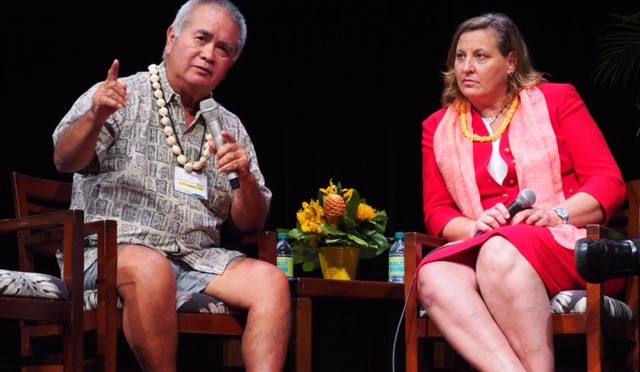I just got back from the 2016 Maui Energy Conference, where I spoke on a panel. It was really interesting how the moderator, Bill Aila, set up our panel. He said:
“Imagine it’s now 2045 and Hawai‘i is a wonderful place because we’re using 100 percent renewable energy. How did we get here?”
I went straight to talking about the Hawai‘i Island Energy Co-op because it’s very simple – it saves money. It’s a non-profit, and all the profits that would otherwise go to shareholders go, instead, to the folks that own meters. It’s predictable. Everything else that is going to happen with energy between now and 2045 is unpredictable. But saving money because of your business model is predictable.
Another reason a co-op is a good model is because the board members have to pay attention and keep up with what the people want or they won’t be re-elected.
The moderator also wanted to emphasize to the audience outside Hawai‘i that things are different here. It’s Hawaiian-style to prepare way in advance. People can’t just come in and look at the balance sheets, say they’re going to invest here and then expect changes to happen really quickly.
Things operate differently here. Hawai‘i’s culture has evolved from a society where relationships were reciprocal, and the more you gave the more you received, to a market economy that is more along the lines of “the more you get, the more you get.” It’s quite different, and there a lingering, uncomfortable feeling that the capitalist system is suspect.
In my opinion, it’s partly why Hawaiians introduce themselves by talking about who they are, with some of their genealogy. You don’t come in here all of the sudden and try to rush things through on us. It doesn’t work that way here in Hawai‘i. We have to know who we’re talking to.
I also used the Thirty Meter Telescope (TMT) as an example. We can’t say that one size fits all, that all telescopes are bad, that a whole mountain is sacred. And the GMO subject, where the anti-GMO folks will say that all GMOs are bad. Well, not really. Some are bad and others are helpful. It depends on what you’re talking about. We can’t talk in generalities.
What are we trying to achieve? I asked. We’re trying to make sure our society benefits all of us, not just some of us. The ends don’t justify the means. That doesn’t work.
I talked about how I came to the TMT project and the two most important things I learned from it: 1) To follow the process, which I learned from Patrick Kahawaiola‘a, and 2) “What about the rest?” which I learned from Kumu Lehua Veincent. I talked about how agriculture and energy are tied together. I even had a chance to talk about my Uncle Sonny Kamahele, who taught me the most important lessons I ever learned about farming.
It was a good discussion. We had a lot of really good feedback.


Very well done, Richard. You right on the kinipopo. When you make up battle plans you define an ultimate set of objective(s). Then you define how you’re going to attain this or those objectives. An assessment of required resources are combined in the overall equation. Hawai’i Island has, to my understanding, fossil fuel energy, geo-thermal looking for a productive foothold, solar, potential wind power, ocean resources capable of generating additional streams of energy. The technical details are not in my repertoire however the program models and programs are. Simply put, start-up costs, non-profit or not, what are the ROIs, percentage energy generation from each energy model (thermal = 26%, solar = 17%, wind turbines = 9%, fossil fuel =
48%). One objective in this simplistic model is chipping away at fossil fuels by increasing the other energy sources (eg, geo-thermal). The fossil fuel group is a focal point; we have very little power (excuse the pun) over this resource. HECO is not the point organization for our future. But, as Richard emphasized, we just can’t “allow” any “investment” entity to come sliding in promising they have the answers [follow the money]. It is better to position ourselves to take responsibility for our own energy needs and requirements.